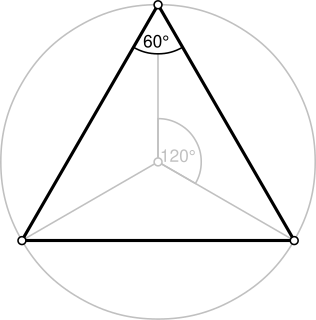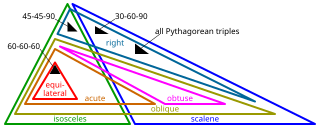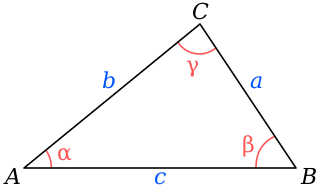
A Pythagorean triple consists of three positive integers a, b, and c, such that a2 + b2 = c2. Such a triple is commonly written (a, b, c), and a well-known example is (3, 4, 5). If (a, b, c) is a Pythagorean triple, then so is (ka, kb, kc) for any positive integer k. A primitive Pythagorean triple is one in which a, b and c are coprime. For example, (3, 4, 5) is a primitive Pythagorean triple whereas (6, 8, 10) is not. A triangle whose sides form a Pythagorean triple is called a Pythagorean triangle, and is necessarily a right triangle.

In mathematics, the trigonometric functions are real functions which relate an angle of a right-angled triangle to ratios of two side lengths. They are widely used in all sciences that are related to geometry, such as navigation, solid mechanics, celestial mechanics, geodesy, and many others. They are among the simplest periodic functions, and as such are also widely used for studying periodic phenomena through Fourier analysis.

A triangle is a polygon with three edges and three vertices. It is one of the basic shapes in geometry. A triangle with vertices A, B, and C is denoted .

A right triangle or right-angled triangle (British), or more formally an orthogonal triangle, formerly called a rectangled triangle, is a triangle in which one angle is a right angle or two sides are perpendicular. The relation between the sides and other angles of the right triangle is the basis for trigonometry.

Angle trisection is a classical problem of straightedge and compass construction of ancient Greek mathematics. It concerns construction of an angle equal to one third of a given arbitrary angle, using only two tools: an unmarked straightedge and a compass.

In geometry, an altitude of a triangle is a line segment through a vertex and perpendicular to a line containing the base. This line containing the opposite side is called the extended base of the altitude. The intersection of the extended base and the altitude is called the foot of the altitude. The length of the altitude, often simply called "the altitude", is the distance between the extended base and the vertex. The process of drawing the altitude from the vertex to the foot is known as dropping the altitude at that vertex. It is a special case of orthogonal projection.

In geometry, a hypotenuse is the longest side of a right-angled triangle, the side opposite the right angle. The length of the hypotenuse can be found using the Pythagorean theorem, which states that the square of the length of the hypotenuse equals the sum of the squares of the lengths of the other two sides. For example, if one of the other sides has a length of 3 and the other has a length of 4, then their squares add up to 25. The length of the hypotenuse is the square root of 25, that is, 5.
A Heronian tetrahedron is a tetrahedron whose edge lengths, face areas and volume are all integers. The faces must therefore all be Heronian triangles. Every Heronian tetrahedron can be arranged in Euclidean space so that its vertex coordinates are also integers.
In geometry, a Heronian triangle is a triangle that has side lengths and area that are all integers. Heronian triangles are named after Hero of Alexandria. The term is sometimes applied more widely to triangles whose sides and area are all rational numbers, since one can rescale the sides by a common multiple to obtain a triangle whose sides and area are integers.
In mathematics, an Euler brick, named after Leonhard Euler, is a rectangular cuboid whose edges and face diagonals all have integer lengths. A primitive Euler brick is an Euler brick whose edge lengths are relatively prime. A perfect Euler brick is one whose space diagonal is also an integer but such a brick has not yet been found.

A special right triangle is a right triangle with some regular feature that makes calculations on the triangle easier, or for which simple formulas exist. For example, a right triangle may have angles that form simple relationships, such as 45°–45°–90°. This is called an "angle-based" right triangle. A "side-based" right triangle is one in which the lengths of the sides form ratios of whole numbers, such as 3 : 4 : 5, or of other special numbers such as the golden ratio. Knowing the relationships of the angles or ratios of sides of these special right triangles allows one to quickly calculate various lengths in geometric problems without resorting to more advanced methods.

In spherical trigonometry, the law of cosines is a theorem relating the sides and angles of spherical triangles, analogous to the ordinary law of cosines from plane trigonometry.

In geometry, Apollonius's theorem is a theorem relating the length of a median of a triangle to the lengths of its sides. It states that "the sum of the squares of any two sides of any triangle equals twice the square on half the third side, together with twice the square on the median bisecting the third side".

A Kepler triangle is a special right triangle with edge lengths in geometric progression. The ratio of the progression is where is the golden ratio, and the progression can be written: , or approximately . Squares on the edges of this triangle have areas in another geometric progression, :\varphi ^{2}} . Alternative definitions of the same triangle characterize it in terms of the three Pythagorean means of two numbers, or via the inradius of isosceles triangles.

In trigonometry, the law of cosines relates the lengths of the sides of a triangle to the cosine of one of its angles. Using notation as in Fig. 1, the law of cosines states

In mathematics, the Pythagorean theorem, or Pythagoras' theorem, is a fundamental relation in Euclidean geometry among the three sides of a right triangle. It states that the area of the square whose side is the hypotenuse is equal to the sum of the areas of the squares on the other two sides. This theorem can be written as an equation relating the lengths of the legs a, b and the hypotenuse c, often called the Pythagorean equation:

An integer triangle or integral triangle is a triangle all of whose sides have lengths that are integers. A rational triangle can be defined as one having all sides with rational length; any such rational triangle can be integrally rescaled to obtain an integer triangle, so there is no substantive difference between integer triangles and rational triangles in this sense. However, other definitions of the term "rational triangle" also exist: In 1914 Carmichael used the term in the sense that we today use the term Heronian triangle; Somos uses it to refer to triangles whose ratios of sides are rational; Conway and Guy define a rational triangle as one with rational sides and rational angles measured in degrees—in which case the only rational triangle is the rational-sided equilateral triangle.

In mathematics, the rational points on the unit circle are those points (x, y) such that both x and y are rational numbers ("fractions") and satisfy x2 + y2 = 1. The set of such points turns out to be closely related to primitive Pythagorean triples. Consider a primitive right triangle, that is, with integer side lengths a, b, c, with c the hypotenuse, such that the sides have no common factor larger than 1. Then on the unit circle there exists the rational point (a/c, b/c), which, in the complex plane, is just a/c + ib/c, where i is the imaginary unit. Conversely, if (x, y) is a rational point on the unit circle in the 1st quadrant of the coordinate system, then there exists a primitive right triangle with sides xc, yc, c, with c being the least common multiple of the denominators of x and y. There is a correspondence between points in the x-y plane and points a + ib in the complex plane which is used below.

In plane geometry, an automedian triangle is a triangle in which the lengths of the three medians are proportional to the lengths of the three sides, in a different order. The three medians of an automedian triangle may be translated to form the sides of a second triangle that is similar to the first one.

In geometry, the inverse Pythagorean theorem is as follows:




















